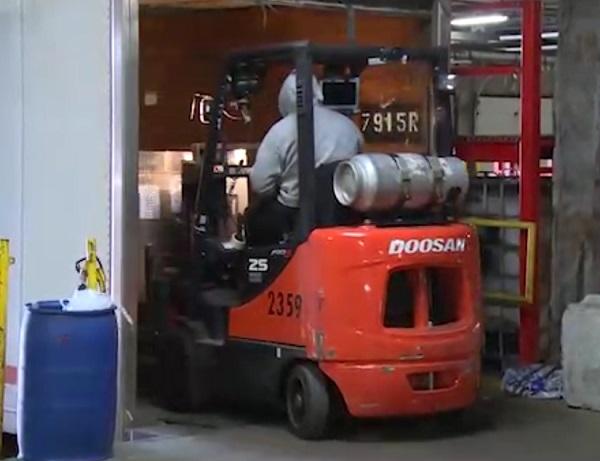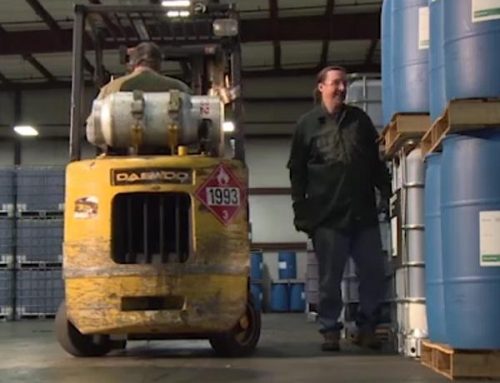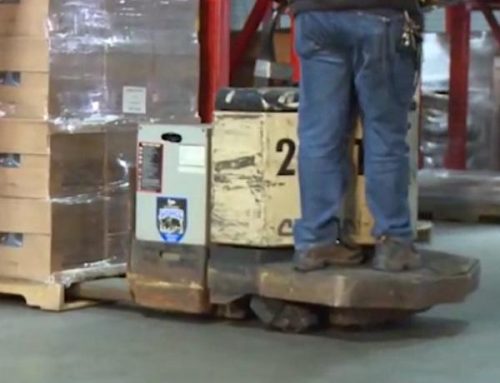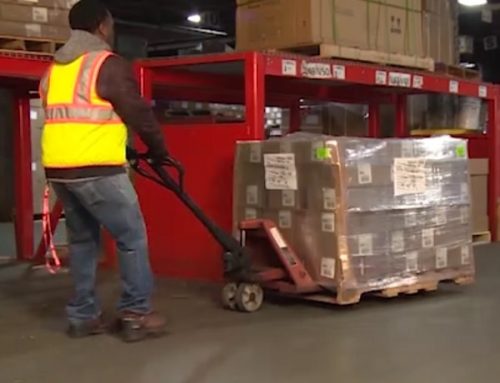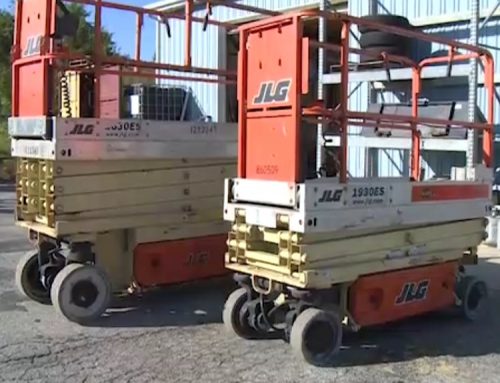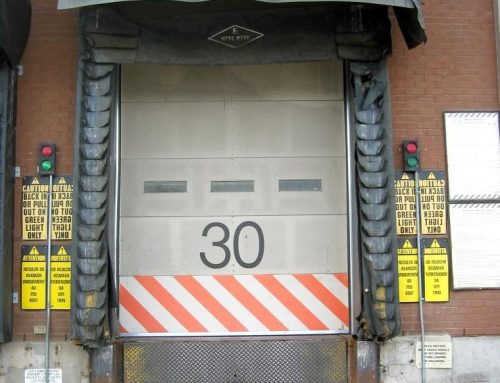Working on a busy loading dock comes with many hazards, including falls, slips, and being struck by vehicles or equipment. This comprehensive loading dock safety guide summarizes key information from an online training course on how to keep loading dock operations safe for everyone. By following proper procedures for fall prevention, hazard awareness, materials handling, and truck securing, you can help prevent injuries and ensure smooth loading and unloading.
Wear Proper Personal Protective Equipment
The loading dock environment requires workers to wear appropriate personal protective equipment (PPE) to minimize injury risks. Different hazards call for specific types of PPE, so it’s important to assess the situation and gear up accordingly.
The hustle and bustle of a loading dock means you need sturdy foot protection and gloves at a minimum. Consider the following PPE guidelines:
- Wear sturdy work boots with steel toes and slip-resistant soles to protect against foot injuries or falls. The elevated platforms of docks present trip and fall hazards.
- Wear thick gloves to protect your hands from scrapes, cuts, or splinters when handling cargo.
- Wear a hard hat or bump cap to protect your head from falling objects or from hitting your head on low clearances.
- Use safety glasses, dust masks, or cold weather gear as needed for the specific loading operation.
Stay Alert to Struck-By Hazards
Loading docks involve heavy machinery and vehicles moving in tight spaces, creating struck-by hazards. Situational awareness and giving equipment the right of way are key to avoiding injuries.
Staying alert and giving equipment the right of way is crucial:
- Never stand, walk or work underneath a raised load.
- Keep clear of moving forklifts, pallet jacks and other equipment. Their operators may not see you.
- Beware of equipment pivoting and the rear end swinging out. Maintain a safe distance.
- Use powered equipment slowly and watch for pedestrians. Drive at a walking pace.
- When not actively driving equipment, lower the forks completely to the ground.
Prevent Slips, Trips and Falls
Spills and clutter on dock surfaces present major slip, trip and fall hazards. Staying on top of housekeeping and cleanup is essential.
Good housekeeping and cleaning up spills is vital to prevent slip and fall incidents on loading docks:
- Promptly remove any water, ice, or snow that accumulates inside or outside the dock.
- Clean up liquid spills, oil, grease or debris that creates slippery conditions.
- Report any holes, cracks, uneven joints or other damage that could trip workers.
- Don’t leave clutter, empty pallets or tools lying around. Keep walkways clear.
- Dispose of packaging materials, straps, shrink wrap, and other trash properly.
Control the Fall Risks of Elevated Platforms
Loading docks are elevated 4-5 feet high, posing significant fall risks. Guardrails, gates and safe working practices help mitigate these hazards.
Minimize the risk by following safe work practices:
- Install guardrails wherever the vertical drop exceeds 48 inches. Use chains or barriers for shorter drops.
- Shut trailer and box truck doors when the dock is not actively being loaded.
- Never jump on or off the dock. Use provided steps.
- Stay back from the edge when opening trailer doors in case cargo inside has shifted.
- Avoid “dock surfing” by walking only on areas with secure flooring. Report damaged surfaces.
Use Safe Procedures for Dock Plates and Levelers
Bridging equipment between the dock and truck trailers presents tripping hazards. Exercise caution:
- Ensure dock plates fully cover the gap between the dock and the trailer with at least 8″ of overlap.
- Retract dock levelers flush with the deck when not in use to prevent tripping.
- Check that bridge slopes are less than 7 degrees. Steeper angles can cause problems.
- Place dock plates in their storage locations when not needed so they don’t become trip hazards.
Secure Trucks and Trailers Properly
Unsecured trucks and trailers lead to potentially disastrous trailer creep, collapse and early departure. Use restraints and procedures to keep vehicles firmly in place during loading/unloading.
Follow these procedures:
- Ensure drivers shut off engines and engage parking brakes when docking.
- Use wheel chocks when loading or unloading with powered equipment. Chocks help prevent creep.
- Utilize built-in mechanical restraints to lock the vehicle’s rear axle or bumper in place. This provides maximum security against trailer creep.
- Install jack stands underneath any dropped semi-trailers to prevent landing gear collapse.
- Hold driver’s keys or use caution lights until loading/unloading is fully completed to avoid early departure.
Use Caution When Operating Equipment
Situational awareness and defensive driving techniques are essential for safely operating forklifts and pallet jacks on crowded docks and inside trailers.
Loading and unloading trucks requires extra care when driving forklifts:
- Check that dock plates are rated to support the forklift and load weight. Ensure they are secure.
- Inspect truck floors for any damage before driving inside.
- Enter trucks squarely at a right angle to dock plates. Sound your horn.
- Drive slowly and avoid sudden acceleration or braking that could cause loads to shift or fall.
- Keep forks low at all times, even when not carrying a load. Lower forks completely when stopped.
- Clean up any liquid spills or slick areas that could cause loss of traction.
Communicate Dock Hazards
Signs, painted warnings, audible back-up alarms, and guards help reinforce loading dock hazards. Clear communication with drivers further enhances safety.
Prevent injuries by communicating loading dock hazards through:
- Safety signs indicating proper PPE, fall hazards, and equipment operating procedures.
- Painted lines marking safe walkways away from the dock edge.
- Mirrors providing visibility around blind corners.
- Audible back-up alarms on powered equipment.
- Guards preventing entry into dangerous areas.
- Safety warnings to drivers about securing trucks against early departure.
Conclusion
Loading docks involve many potential hazards, but safe operations are possible by following proper procedures. Operators should use the safety tips outlined here regarding fall prevention, struck-by avoidance, hazard communication and proper equipment operation. Managers must ensure equipment is maintained and that docks are kept clean and free of slip, trip and fall hazards. Drivers also play a key role in turning off engines and properly securing trucks and trailers during loading and unloading. With a shared commitment to safety from all personnel, items and people can continue moving efficiently through loading areas without injury.
With the detailed guidelines outlined in this comprehensive loading dock safety guide, it’s clear that a systematic approach to safety can significantly mitigate the risks inherent in such a dynamic environment. From wearing the right personal protective equipment to understanding and communicating the specific hazards of loading docks, every aspect is crucial in maintaining a safe and efficient operation. However, the key to truly empowering your workforce and cementing these safety practices lies in effective training. This is where our specialized training course comes into play, offering a seamless transition from understanding the principles of loading dock safety to applying them in everyday scenarios.
Transform your loading dock into a pinnacle of safety and efficiency with Our “Loading Dock Safety” online safety training course. Designed for the dynamic and potentially hazardous environment of loading docks, this course is a vital resource for businesses looking to enhance safety, reduce accidents, and maintain a productive workflow.
Why Invest in Our Loading Dock Safety Training?
- Targeted Safety Training: Our course is tailored specifically for the unique challenges of loading docks. It covers a range of hazards that employees may encounter, ensuring comprehensive preparedness.
- Diverse Learning Formats: We offer a mix of learning formats including Micro-Learning modules, full-length online courses, DVDs, and interactive CD courses. This variety caters to different learning preferences and schedules.
- Practical and Relevant Topics: The training encompasses critical areas such as safe working procedures, preventing slips, trips, and falls, docking transport vehicles, and safely operating materials handling equipment on a dock.
- Engaging and Interactive Learning: Our courses are designed to be engaging and interactive, keeping your team involved and attentive. This approach enhances learning retention and practical application.
- Future-Proof Your Team: With the constant evolution of workplace safety standards, our course ensures that your team stays ahead of the curve, equipped with the latest best practices in loading dock safety.
- Bilingual Options: Currently available in English and soon in Spanish, our training ensures inclusivity, making it accessible to a diverse workforce.
- Efficient MicroLearning Curriculum: Short on time? Our MicroLearning curriculum offers concise 3 – 5 minute courses focusing on key safety aspects, perfect for busy schedules without compromising on quality.
- Compliance and Beyond: While helping you meet OSHA standards, our training also instills a culture of safety, reducing the risk of injuries and fatalities, and enhancing overall productivity.
- SCORM 1.2 Compliant: Our courses are compliant with SCORM 1.2 standards, ensuring compatibility and easy integration with your existing training systems.
Elevate Your Loading Dock Operations with Our Comprehensive Safety Training – Your Pathway to a Safer, More Efficient Workplace!
Click on the link below to access our free demo:


